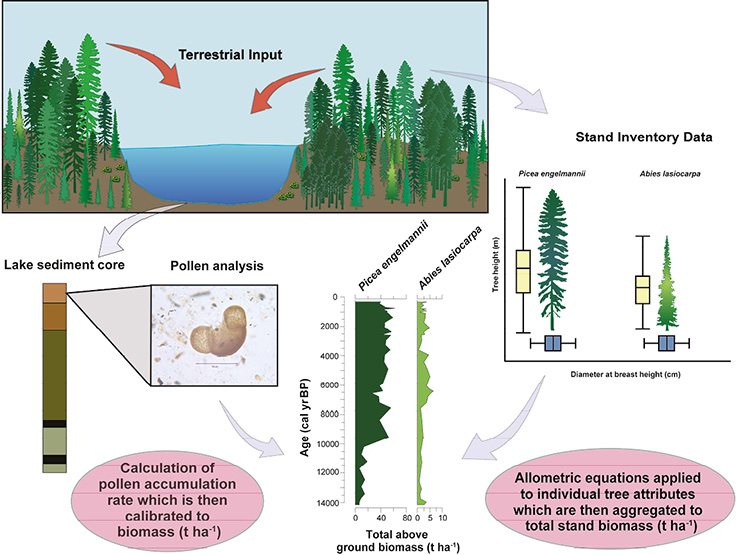- Home
- Publications
- PAGES Magazine
- Identifying Data Gaps and Potential Synergies In Forest Dynamics Research
Identifying data gaps and potential synergies in forest dynamics research
Morris J, Clear J, Chiverell R, DeRose RJ & Drobychev I
Past Global Changes Magazine
26(2)
86
2018
Jesse Morris1, J. Clear2, R. Chiverell3, R.J. DeRose4 and I. Drobychev5
Liverpool, UK, 21-23 March 2017
Disturbance events, such as wildfire and bark beetle outbreaks, are natural processes that promote forest regeneration and succession. As climate change propels ecosystems and disturbance regimes along new trajectories, retrospective ecological records, like those derived from tree rings and lake sediments, become important in understanding and anticipating future environmental change. Paleoenvironmental records are essential to inform conservation and management efforts to characterize baseline ecosystem services and recovery rates from disturbances.
In March 2017, PAGES’ Forest Dynamics working group assembled a team of 29 scientists, including 14 early-career researchers, from 13 nations to explore new approaches to reconstructing forest disturbances. The workshop occurred at Liverpool Hope University (UK). The first workshop day was in conference format where participants gave research talks in themed oral presentation sessions. The second day was organized around group discussions that explored four broad themes:
(1) Improving reconstructions of non-fire disturbances
While advances have occurred in recent decades in the reconstruction of paleofires from tree-ring and lake-sediment records, non-fire disturbance events, such as insect and pathogen outbreaks, are largely unaccounted in paleoenvironmental studies. Non-fire disturbances are important drivers of forest succession, yet they are challenging to reconstruct because indicators that conclusively diagnose the disturbance are infrequently recovered, as in the case with bark beetles (Morris et al. 2015). However, increasing the volume of sediment sub-samples (Whitehouse et al. 2010) may enhance macrofossil recovery, including insect remains, which would improve their utility as a proxy for outbreak events. Recent work by Stivrins et al. (2017) provides an encouraging example in reconstructing non-fire disturbances, where the authors identified and counted non-pollen palynomorphs from a fungal pathogen (Phytophthora) to explain the decline of alder (Alnus spp.) in Europe during the medieval period.
(2) Reconstructing the severity of forest disturbances
Discussions centered on how to better integrate lake-sediment proxies with tree-ring and forest-inventory data. In some instances, forest-inventory records have been combined with pollen records to produce estimates of past forest cover as aboveground biomass (Seppä et al. 2009). A key advance in assessing past disturbances centers on the quantifying tree mortality resulting from the event (i.e. severity). Biomass may aid in quantifying the severity of plant mortality as a result of a disturbance. Severity reconstructions could be enhanced by integrating mortality data from individual trees (tree rings), stands (forest hollows) to landscapes (lakes).
(3) Opportunities for database integration
 |
|
Figure 1: Conceptualization of transforming pollen data to biomass (t/ha) using stand demographic data. |
One practical approach to determining potential sites to link records of forest dynamics would be to integrate existing databases. For example, integrating databases through geolocation would simplify the identification of study areas for synergistic work. Several databases were discussed, including Neotoma (neotomadb.org), the NOAA National Centers for Environmental Information (ncdc.noaa.gov/paleo), and forest inventory databases, such as the USDA Forest Inventory and Analysis (fia.fs.fed.us/tools-data). Database integration presents a key opportunity to advance reconstructions of past forest conditions, especially in leveraging quantitative approaches to reconstruct land cover (Fig. 1).
(4) Key methods for data integration
The final discussion centered on new methods for integrating lake-sediment proxy data across scales. Generally, data integration across scales can be challenging even when using a single proxy (e.g. pollen). Examples from the first day’s presentations were highlighted. Quantitative pollen techniques, such as the Landscape Reconstruction Algorithm (LRA) (Sugita 2007), help to compare vegetation reconstructions across spatial and temporal scales, though with noted issues (Trondman et al. 2016). Recently, Carter et al. (2018) used the LRA approach to integrate pollen profiles from 10 peat bogs with four lake records to reconstruct total land-cover abundance across local- to regional-scales. Their approach provides information that is relevant for conversation and ecosystem management strategies in Central Europe.
Future activities
The next Forst Dynamics' activity will be to write a synthesis paper with the working title “Pairing dendrochronological and paleoecological approaches to reconstructing past disturbances events.”
acknowledgements
This workshop was supported by PAGES and the Liverpool Hope University.
affiliations
1Department of Geography, University of Utah, Salt Lake City, USA
2Department of Geography, Liverpool Hope University, UK
3Department of Geography, University of Liverpool, UK
4Forest Inventory and Analysis, USDA Forest Service, Ogden, USA
5Swedish University of Agricultural Sciences, Alnarp, Sweden & University of Quebec at Abitibi-Temiscamingue, Canada
contact
Jesse Morris: jesse.morris utah.edu
utah.edu
references
Carter VA et al. (2018) Fron Earth Sci 8: 2268
Morris JL et al. (2015) Quat Int 387: 72-86
Seppä H et al. (2009) Holocene 19: 209-220
Stivrins N et al. (2017) J Quat Sci 32: 903-907
Sugita S (2007) Holocene 17: 229-257
